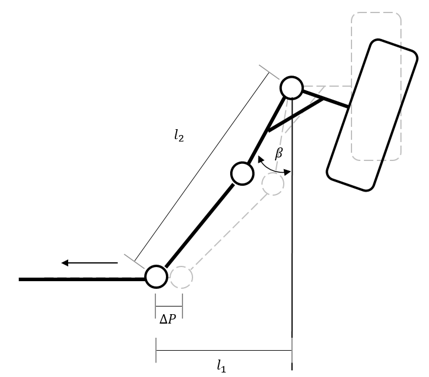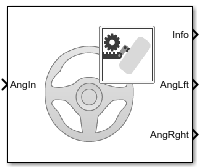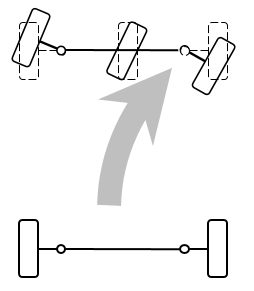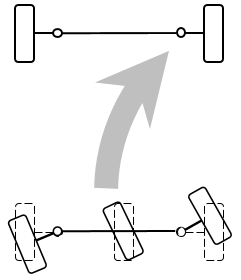Kinematic Steering
Kinematic steering for Ackerman, rack-and-pinion, and parallel steering mechanisms
Libraries:
Vehicle Dynamics Blockset /
Steering
Description
The Kinematic Steering block implements a steering model to determine the left and right wheel angles for Ackerman, rack-and-pinion, and parallel steering mechanisms. The block uses the vehicle coordinate system.
To specify the steering type, use the Type parameter.
| Setting | Block Implementation |
|---|---|
| Ideal Ackerman steering, adjusted by percentage Ackerman. Wheel angles have a common turning circle center. |
| Ideal rack-and-pinion steering. Gears convert the steering rotation into linear motion. |
| Parallel steering. Wheel angles are equal. |
To specify the type of data for the steering mechanism, use the Parametrized by parameter.
| Setting | Block Implementation |
|---|---|
| Steering mechanism uses constant parameter data. |
| Steering mechanism implements tables for parameter data. |
Use the Steered axle parameter to specify whether the front or rear axle is steered.
| Setting | Implementation |
|---|---|
| Front | Front axle steering
|
| Rear | Rear axle steering
|
Steering Types
For ideal Ackerman steering, the wheel angles have a common turning circle.

To calculate the ideal wheel angles, the block uses these equations.
After the block calculates the ideal wheel angles, it uses the Ackerman percentage to adjust the outside wheel angle.
The outside wheel angle depends on the turn direction.
Right turn
Outside angle, δo, is left wheel angle, δL
Inside angle, δi, is right wheel angle, δR
Left turn
Outside angle, δo, is right wheel angle, δR
Inside angle, δi, is left wheel angle, δL
The illustration and equations use these variables.
| δin | Steering angle |
| δL | Left wheel angle |
| δR | Right wheel angle |
| δo | Outside wheel angle |
| δi | Inside wheel angle |
| pAck | Ackerman percentage |
| TW | Track width |
| WB | Wheel base |
| γ | Steering ratio |
For ideal rack-and-pinion steering, the gears convert the steering rotation into linear motion.


To calculate the steering angles, the block uses these equations.
The illustration and equations use these variables.
| δin | Steering wheel angle |
| δL | Left wheel angle |
| δR | Right wheel angle |
| TW | Track width |
| r | Pinion radius |
| ΔP | Linear change in rack position |
| D | Distance between front axis and rack |
| lrack | Rack casing length |
| larm | Steering arm length |
| lrod | Tie rod length |
For parallel steering, the wheel angles are equal.

To calculate the steering angles, the block uses this equation.
The illustration and equations use these variables.
| δin | Steering wheel angle |
| δL | Left wheel angle |
| δR | Right wheel angle |
| γ | Steering ratio |
Examples
Ports
Input
Output
Parameters
References
[1] Crolla, David, David Foster, et al. Encyclopedia of Automotive Engineering. Volume 4, Part 5 (Chassis Systems) and Part 6 (Electrical and Electronic Systems). Chichester, West Sussex, United Kingdom: John Wiley & Sons Ltd, 2015.
[2] Gillespie, Thomas. Fundamentals of Vehicle Dynamics. Warrendale, PA: Society of Automotive Engineers, 1992.
[3] Vehicle Dynamics Standards Committee. Vehicle Dynamics Terminology. SAE J670. Warrendale, PA: Society of Automotive Engineers, 2008.
Extended Capabilities
Version History
Introduced in R2018a



